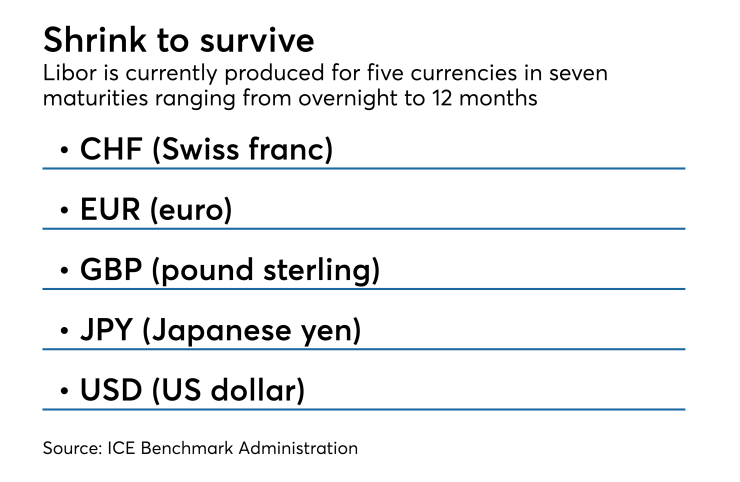While banks will no longer be compelled by U.K. regulators to submit quotes for the calculation of Libor after 2021, there is nothing preventing them from doing so. The ICE Benchmark Administration, which has been responsible for calculating the index since mid-2013, thinks there is a strong case for keeping it going.
“The vast majority of participants we engage with — banks, borrowers, investors — have encouraged us to find a framework for retaining Libor over the long term,” ICE President Timothy Bowler said in a speech at a securitization industry conference Monday.
The London interbank offered rate is the average of interest rates estimated by each of 16 panel banks of what it would be charged to borrow from other banks.

Bowler and others at the Structured Finance Industry Group’s annual conference in Las Vegas believe that the replacement being promoted by a committee formed by the Federal Reserve may be appropriate for swaps and derivatives contracts. But it is not suitable for many kinds of loans because it is based on financing that is essentially risk free, and so does not reflect banks’ funding costs.
And initially, there will only be one index for overnight rates. Longer-term rates are not expected to be available until the end of 2021, well after the 16 panel banks can stop submitting quotes for Libor.
“Financial markets should have a set of reference rates that incorporate bank fund costs and provide a prudent benchmark for setting [interest] rates multiple months in advance,” Bowler said.
This would be a much smaller set of benchmarks than the five currencies and seven maturities currently published. Bowler said the ICE is surveying panel banks, other global banks and end users about which currencies and tenors are the most important to them.
“The vast majority of activity is concentrated in a few currencies and tenors,” he said. "If we can narrow down the universe, more banks might be willing to continue providing quotes. It’s far less worrisome for a compliance department to evaluate six numbers, rather than 35.”
The ICE is also taking steps to ensure that Libor is robust even if some of the panel banks opt to stop supporting it. The administrator is considering using an expanded universe of unsecured debt transactions in both the primary and secondary markets, and not just interbank lending, to calculate the index.
Bowler stressed that it is ultimately up to the banking industry to decide whether it wants to continue to support Libor on behalf of its clients.
Fitch Ratings rates some $500 billion worth of transactions backed North American assets that are indexed to Libor, including student loans, collateralized loan obligations, residential mortgage-backed securities, auto loans, credit card receivables and commercial mortgage-backed securities.
“If it can be preserved, it really should be,” Doug Murray, a managing director at Fitch, said at a panel after Bowler’s speech. He said that capital market participants need to know in advance whether enough banks are willing to support the index. “We need a forward commitment by banks,” he said.
Ronni Neeman, vice president, structured products at PGIM Fixed Income, said that Libor should not be preserved in its current form but that some of the changes the ICE is contemplating could help significantly.



